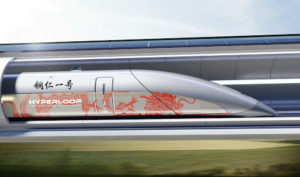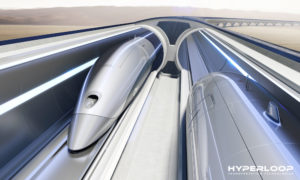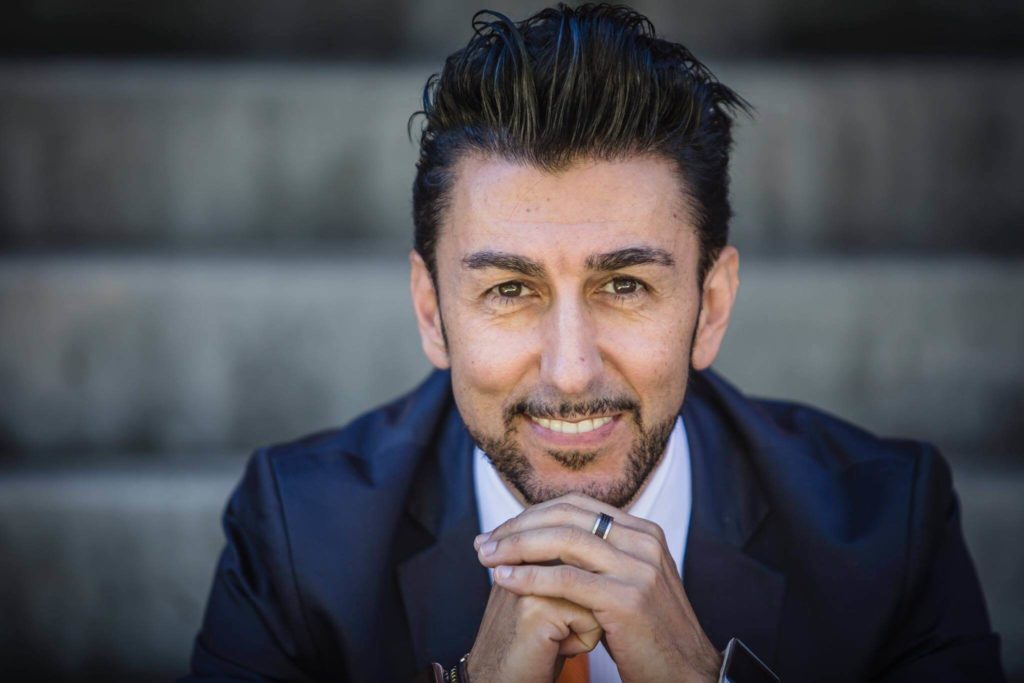Hyperloop Transportation Technologies (Hyperloop TT) aspires to build 2,000 kilometers futuristic Hyperloop lines in China one day, says the firm’s co-founder and chairman Bibop Gresta.
“We are talking to five provinces right now. Guizhou is the first one we signed,” Gresta told China Money Network during an interview on the sidelines of the Annual Meeting of the New Champions held by the World Economic Forum in Tianjin.
Hyperloop TT has already sealed a deal with Guizhou province in China’s southwestern region to build its first track in the country, the company said in an announcement two months ago. The deal marks the third commercial agreement for Hyperloop TT, following announcements on similar agreements in Abu Dhabi and Ukraine earlier in 2018.
“In the future, we will not build, maintain or operate anything but act as a licensing company with enormous knowledge and intellectual property (IP) technologies,” Gresta said. “In Guizhou, we are foreseeing a six-month feasibility study, and then 38 months to implement the first line. We are talking about an overview of a maximum of five years to add the first passenger in China. Then we are planning to roll out 2,000 kilometers in China.”
According to the People’s Daily, the hyperloop project in Tongren, Guizhou province, is expected to cost about RMB10 billion (US$1.5 billion), covering a total distance of 60 kilometers (37.2 miles).
The California-based Hyperloop TT focuses on building hyperloop systems enabling capsules to travel in a vacuum tube, an idea first proposed by technology magnate Elon Musk. The technology is said to be able to move capsules reaching speed of up to 1,223 kilometers per hour (760 mph).


Hyperloop TT’s ambitious plans in China comes at a time when the country is embroiled in a fierce trade war with the United States. The White House and U.S. President Donald Trump have repeatedly blamed China for unfair trade practices, IP infringements, and forced technology transfers. Gresta also discussed how his company deals with intellectual property protections when doing business in China.
Read an interview Q&A below. Also subscribe to China Money Podcast for free in the iTunes store, or subscribe to our weekly newsletter.
Q: For those who are not familiar, please give us a brief introduction of hyperloop Transportation Technologies?
A: My company is the first company to bring Elon Musk’s vision to travel inside a tube at the speed of sound into reality. Imagine putting a capsule full of people inside a tube, sucking the air out of the tube so there’s no resistance, and you can move people from point A to point B at almost the speed of sound using a tiny fraction of energy. Sounds like science fiction but we are actually building it.
Q: How much progress have you made in R&D? How ready is this technology now?
A: We have finished all the testing and prototyping, and now construction has started. There is a big prototyping construction in Toulouse, France. It will be divided into two parts. One is 320 meters and the other is 1.4 kilometers. This is the certification track which will also be used to certify the technology.
We have already started the development of the first commercial line in Abu Dhabi. Most recently, we signed a deal with the local government in Tongren City in Guizhou province to build the first commercial line in China.
Q: Certainly, there is a lot of potential, but there are also lots of criticisms and questions about how the technology will be realistic in terms of costs and potential risks. One of those criticisms comes from the consideration for safety.
Could you tell us a little bit about safety concerns and how do you plan to handle this issue?
A: All the criticisms are based on the initial designs of the hyperloop. Nobody has really looked into what we are doing. The most important thing you have to understand about the hyperloop is that it is based on existing technologies.
Firstly, what we did is to put together partners and developers who have already built all the pieces of the technology. The biggest challenge is the tube. We use one of the top tube manufacturers in the world who produced the first tube in carbon steel. Then, we also use new polymers, which is a new material that augments resistance and can be extruded in place. The tube is capable of being 4-meter in diameters, allowing enough capsule-tube ratio so not to have any problems with any impairments.
The most important thing about the tube is when we pressurize it into one pascal, we create a situation in which the capsule is completely without fatigue. So we don’t have the stress the aerospace industry has to deal with. It’s like having a big airplane without wings and breaking points.
Q: The tube is near vacuum, right?
A: Yes, the near vacuum is obtained through the pumping system in every 10 kilometers. We have 10 containers. Each contains pumps. We bring down the pressure from one bar of the outside pressure to one pascal, which is almost the pressure in the space.
As soon as you have the pressure maintained, you need only 10% of the energy to maintain the vacuum. So it is very efficient. You don’t need any complicated instruments to maintain the air pressure and we use existing pumps to obtain the vacuum.
Q: What will happen if there’s an earthquake, or a natural disaster, or a tiny fracture in the tube’s structure?
A: Let’s divide the problem. The first thing is how to build a system that can resist 9.2 Richter scale. That is not complicated because we have technologies that can actually build pylons on 30,000 pounds per square inch (psi) of resistance, which means 200,000 kilopascal per square foot. By using a new type of concrete that can create a perfect situation which can actually withstand this kind of earthquake. We use seismic isolators to create a compensation method to allow the tube to expand.
Then we use thermal expansion joints, which is a very old technology that has been used in pump manufacturing since the 1950s. These problems are being solved long time ago and we are implementing it in the most innovative way.
The other aspect is how to maintain the safety inside the tube. When the human body is exposed to vacuum, there is potentially a danger. In reality, if we have a problem, we can seal the section of the tube with the problem, and then open the valves immediately. So the air refill the tube and we are reassured the so-called Armstrong limit. In this way, the body doesn’t have any problems living or breathing and people can evacuate from the emergency exit. So it’s the safest thing built on the ground, which also guarantees extreme efficiency.
Safety is also considered when we built the hyperloop. You can’t have a capsule stuck in the middle or divert a capsule inside the building. And you are protected from the external agents like the weather or the sand.
The most important aspect is we eliminated the biggest killer in transportation: human. Human error causes 70% of all accidents in transportation industry. We use artificial intelligence to maintain not only coherence between the capsule, but also the safety and control of the capsule. We supervise it by humans. It is the safest (transportation method) ever designed on the ground.
Q: Another issue is its costs. How do you justify the costs of building a brand new infrastructure in order to implement this new technology, when we have so many methods of transport already?
A: Two of the main costs on transportation are related to the right of way and the electrification of the track.
In the first issue, we try to build on top of rails or on top of highways. When we cannot, we go underground. These will drastically diminish the impact on the ground because we don’t bifurcate the land. It doesn’t diminish the value of the land.
The other important aspect is the cost per kilometer. If you analyze various expenses in the case of rails or high-speed rails, it is the electrification (that is very expensive). Electrification means you have to build miles and miles of rails. And you have to electrify them and also generate the backbone of the infrastructure. In the case of the high-speed rails, you also have to bring it to super connectivity. The levitation system is made using active levitation, which means you consume tremendous amount of energy that results in no one on the ground making money. These entire infrastructures are based on subsidies.
In the case of the hyperloop, you have a tube with minimal consumption for the vacuum that acts to levitate the capsule. On the tube there is only laminated aluminum. On the capsule there are giant neodymium magnets that basically are configured to act with the passive levitation system, which means it doesn’t need electricity.
With the principle that was discovered in 1995 by the Lawrence Livermore lab, you can actually levitate the capsule using a principle called “recurrent”. So by moving these specially-configured magnet, you are capable of generating a levitation without using electricity. You just need a linear motor to push the capsule and you can levitate in a very cheap and more efficient way. The result is a system that can achieve the investment in eight to fifteen years. It’s unprecedented.
Governments now can work with private companies like Hyperloop Transportation Technologies to build a private public partnership where the government puts 20% and the private company puts 80%. Both the private company and the government can achieve their investment targets. The consortium pays and feeds to the government to actually run the infrastructure.
Q: Have you taken the Shanghai Maglev train? What do you think of it?
A: Of course. I think the overall experience is mediocre. It’s not human-centric.
At hyperloop, we employ a completely different approach. Instead of moving as many people as we can, and from one point to another very inefficiently, we move as many capsules as possible so that capsules can depart every 30 seconds. The first capsule can go to point B, and the second one to point C, and the third one to point D. And we will be completely optimized and offering the service you need by tailor-made space, using new technologies to guarantee content and services around you needs. This is a brand-new concept of transportation.
Q: By taking the Shanghai maglev train and experience how smooth they move, did you get any inspirations or lessons or other takeaways?
A: The high-speed rail can show you how relative is the speed. We are not feeling the speed inside a train like this because we are accelerating slowly enough in order to not feel it.
The hyperloop works the same way. The only difference is that we will be accelerating more up to the speed of sound without making you feel the journey. The speed of sound is not a measure of speed but a measure of acceleration. And the trick is to accelerate less than 1G in horizontal and less than 0.5G in lateral, so you can constantly have a comfortable passenger experience. At that speed, you will not be able to feel anything.
Q: Tell us a little bit more about the Chinese project you have been able to make with Guizhou province. How did that take place?
A: We have deeply studied China in the past five years, looking for the right partners and the right governments with the right vision. We were in talk with different provinces, but Guizhou province has incredible opportunities to be the fastest-growing Chinese province even if it is currently one of the poorest. It’s actually the most aggressive province in terms of developing and leapfrogging their infrastructures. They also have mountains. The harsh environment is very attractive and also challenging for us because it can allow us to experiment, and to develop several new technologies.
We have already partnered with Winsun, which is a Chinese 3D printing technology company and the market leader in this technology. Combining with our special patents and measures, it will become a very interesting opportunity to actually develop technology in this kind of terrains. Then we can support worldwide civilian occasions. For us, Guizhou is the No.1 tourist destination for Chinese travellers, so it’s also a very meaningful place to build the first hyperloop in China.
Q: How many cities or provinces did you talk to before settling down on Guizhou?
A: We are talking to five provinces right now. Guizhou is the first one we signed.
Q: So you might sign more in the future?
A: There are discussions to look at other projects.
Q: What’s your overall impression on working with the Chinese government when they try to attract foreign technology like the company you are leading. Was it easy to work with them?
A: We have seen a revolution in our relationship with the Chinese government. The big issue is skepticism. Now we are getting into a new phase that’s actually seeing more concrete understanding of the opportunity of the hyperloop for China.
In countries like China, the opportunity of hyperloop is enormous. Because the density of population, the need for a faster, sustainable and more efficient way to move people and cargo, the governing party is embracing this new technology and become more courageous in experimenting and implementing solutions.
We know highways, roads and high-speed rails are not the right solution for China. They don’t scale. They are too expensive and very inefficient. And they create giant problems in terms of quality of life of Chinese people. Beijing is now on the verge of collapse in terms of pollution and car accidents, so they need a new solution.
Q: What kind of support can you get from the Guizhou government for example?
A: We are discussing possible core investment opportunities involving local partners. The idea is to form a consortium that involves not only the government but also valuable players and industrial partners. We will be able to announce the amazing line-up of the companies we have been able to pull together to perform this project. We are very excited.
Q: Is this investment consortium method the preferred way for your future projects?
A: Absolutely. The way the Hyperloop Transportation Technologies is structured — in the future, we will not build, maintain or operate anything but act as a licensing company with enormous knowledge and intellectual property (IP) technologies. These skills will be put at the disposal of local partners who will build, maintain and operate the structure locally.
Q: There is a lot of concern in foreign companies, especially technology companies, when they come to China. They are worried about intellectual property protection.
How concerned are you? What kind of actions are you taking to make sure your technologies don’t get infringed?
A: We will make sure that the core technologies will be produced outside of China for now. When the partnership consolidates, one of the first topics of the first workshop that we are doing within Guizhou is about this topic. What we are doing then is to ask the Guizhou government in the first workshop, to answer this question: Can you help us trust you and create the right ecosystem to guarantee that the IPs are respected?
We are working in an environment where everybody puts their assets and knowledge together. China is seeing the evolution of this new entrepreneurship spirit. And the country is advanced in a lot of technologies and fields itself. I’m sure there is a new consciousness growing nowadays inside China’s ecosystem, which is that they need to start looking very seriously at implementing copyrights and solutions that can guarantee not only copyright of foreigners in the Chinese market, but also the Chinese technologies that are respected by us. I’m sure we are facing a new moment of entrepreneurship in China that will certainly pass on the respect of the IPs and IPs of the partners.
Q: What do you think are some potential ways the Chinese government, or your Chinese partners, can do to make you more comfortable with licensing your technology?
A: Co-investment in the company is a good way. The success of projects will be leaned on both sides. If we can put some sort of guarantees with some heavy penalties in cases of breach, that would be helpful. But I think the most important guarantee is about forming a climate of relationship of trust. When partners are all contributing and adding value to the partnership, I think we can grow an amazing business story together.
Q: Give us some projections regarding the Guizhou project, in terms of timetables, and also other potential projects not only in China, but also around the globe?
A: In Guizhou, we are foreseeing a six-month feasibility study, and then 38 months to implement the first line. We are talking about an overview of a maximum of five years to add the first passenger in China. Then we are planning to roll out 2,000 kilometers a year, all in China.
Q: Are you aware of any Chinese start-ups that are trying to develop similar technology as Hyperloop Transportation Technologies?
A: Well, I read a couple of articles. With the deeper knowledge, we realize there is nothing concrete about it. I strongly support competition with other companies. We were alone in the market for two years before starting to see other companies implement it. We would be very happy if other companies want to join this amazing journey. Of course, we own the brand of hyperloop, so we will license the brand to other companies who want to embark this journey. But we are sustaining and hoping in the future there will be 10 hyperloops. We have a giant market to develop together and I hope this will happen on a level.

